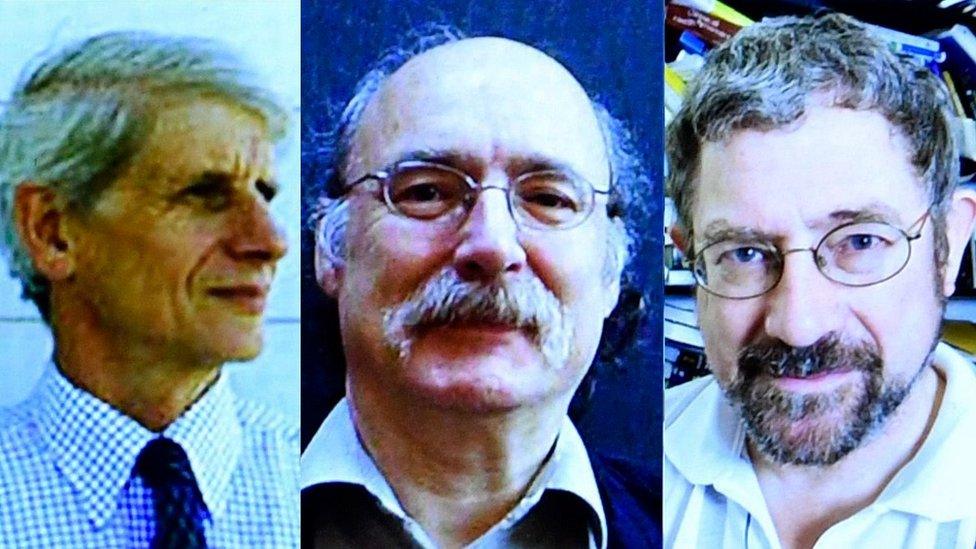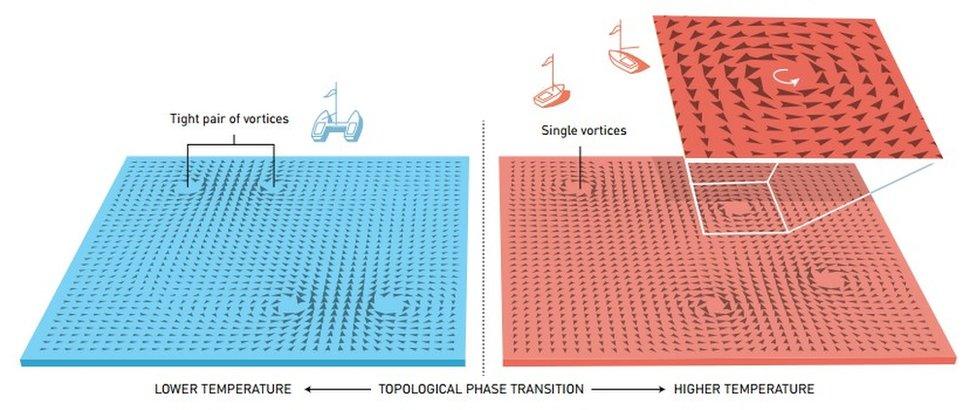Strange matter wins physics Nobel
- Published

(L-R) David Thouless, Duncan Haldane and Michael Kosterlitz
The 2016 Nobel Prize in Physics has been awarded to three British-born scientists for discoveries about strange forms of matter.
David Thouless, Duncan Haldane and Michael Kosterlitz will share the 8m kronor (£727,000) prize.
Their work could result in improved materials for electronics and is already informing one approach to super-fast computing.
They were named at a press conference in Sweden.
The winners join a prestigious list of 200 other Physics laureates recognised since 1901.
The Nobel Committee said the trio's discoveries had "opened the door on an unknown world".
Old work, new uses
When matter is in extreme conditions, such as when it's very cold or flat, scientists start to see unusual behaviour from the atoms.
These phenomena complement the familiar phases of matter, namely when things change from solid to liquid to gas.
Prof Haldane commented: "I was very surprised and very gratified."
Prof Haldane: "You can't wake up in the morning and say 'I'm going to discover something big today'"
"The work was a long time ago but it's only now that a lot of tremendous new discoveries are based on this original work, and have extended it."
All three researchers used maths to explain strange physical effects in rare states of matter, such as superconductors, superfluids and thin magnetic films.
Kosterlitz and Thouless focused on phenomena that arise in flat forms of matter - on surfaces or inside extremely thin layers that can be considered two-dimensional.
This contrasts with the three dimensions (length, width and height) with which we usually describe reality.
Haldane also studied matter that forms threads so thin they can be considered one-dimensional.
Much of the work involves a field of maths known as topology, which describes properties of matter at large and small scales.
Acting chairman of the Nobel committee, Prof Nils Mårtensson, commented: "Today's advanced technology - take for instance our computers - relies on our ability to understand and control the properties of the materials involved.
"And this year's Nobel laureates in their theoretical work discovered a set of totally unexpected regularities in the behaviour of matter, which can be described in terms of an established mathematical concept - namely, that of topology.
"This has paved the way for designing new materials with novel properties and there is great hope that this will be important for many future technologies."

The physics of strange matter - an example

Phase transitions occur when matter changes from one phase to another, such as when ice melts and becomes water
Kosterlitz and Thouless described a type of phase transition in a thin layer of very cold matter
In the cold, vortices form (diagram) as tight pairs, but at higher temperatures, as the phase transition occurs, they separate and "sail" off in different directions

One aspect of the work, known as the Quantum Hall effect, has led to a real-world application.
Prof Nigel Cooper, from the University of Cambridge, told BBC News: "The Quantum Hall effect is used in metrology to give a precise definition of the Ohm in resistance.
Just as a kilogram or a metre requires an exact definition, the maths behind today's Nobel prize has helped precisely describe the unit of electrical resistance - how a device or material reduces the electrical conductance flowing through it.
As an application, he said, "it's not in your iPhone, but it's used in government labs around the world."
"There are many aspects of topology people point to that could be relevant in future, but these are not things that are working today."
For instance, Prof Cooper explained, scientists are exploring whether topological concepts could be used in "robust quantum devices which can do things that classical computers or classical circuit elements are unable to do".
Microsoft's Station Q project is taking just such an approach to the development of powerful quantum computers.
"The topological aspects can give the quantum information a robustness against being destroyed by the usual noisy environment," said Prof Cooper.
In addition, he said, topological metals could be used in the manufacture of improved conductors or transistors.

Previous winners of the Nobel Prize in physics
2015 - Takaaki Kajita and Arthur McDonald were awarded the prize the discovery that neutrinos switch between different "flavours".
2014 - Isamu Akasaki, Hiroshi Amano and Shuji Nakamura won the physics Nobel for developing the first blue light-emitting diodes (LEDs).
2013 - Francois Englert and Peter Higgs shared the spoils for formulating the theory of the Higgs boson particle.
2012 - Serge Haroche and David J Wineland were awarded the prize for their work with light and matter.
2011 - The discovery that the expansion of the Universe was accelerating earned Saul Perlmutter, Brian P Schmidt and Adam Riess the physics prize.
2010 - Andre Geim and Konstantin Novoselov were awarded the prize for their discovery of the "wonder material" graphene.
2009 - Charles Kuen Kao won the physics Nobel for helping to develop fibre optic cables, external.

Although British in origin, the three individuals all now live and work in the US.
David Thouless was born in 1934 in Bearsden. He is an emeritus professor at the University of Washington.
Duncan Haldane was born in 1951 in London. He is a professor of physics at Princeton University.
Michael Kosterlitz was born in 1942 in Aberdeen. He is currently affiliated to Brown University.
Follow Paul on Twitter., external